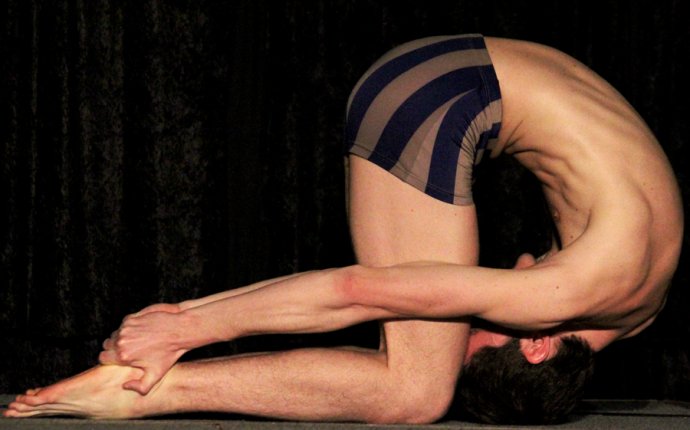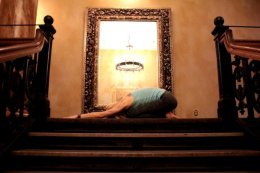
Yoga for Spine Flexibility
 To paraphrase Kundalini Yoga Master Yogi Bhajan, “You may die, but you will never grow old if your spine stays flexible.” I buy that. Just from my own experience, I know that I feel better, think better, and have more energy when my spine is strong, flexible, and pain free. To have a healthy back and spine, it's true that core strength and flexibility in the hamstrings are both essential. But we can’t overlook the benefits of a yoga practice focusing on the strength and health of our spines. Just remember to be where you are today as you practice (not where you were a month ago or where you’ll be in two weeks — respect the body and listen when it talks).
To paraphrase Kundalini Yoga Master Yogi Bhajan, “You may die, but you will never grow old if your spine stays flexible.” I buy that. Just from my own experience, I know that I feel better, think better, and have more energy when my spine is strong, flexible, and pain free. To have a healthy back and spine, it's true that core strength and flexibility in the hamstrings are both essential. But we can’t overlook the benefits of a yoga practice focusing on the strength and health of our spines. Just remember to be where you are today as you practice (not where you were a month ago or where you’ll be in two weeks — respect the body and listen when it talks).
OK! Let’s start growing young, shall we?
Child's Pose
Since we’re working with the back — its flexibility, strength, and balance — let’s just draw our attention to it. Feel free to take any version of Child’s Pose that feels good to you — your arms can be anywhere, knees apart or together, adding props as needed. Inhale and feel the expansion of the back body; feel each vertebrae separate, ever so slightly. Then exhale and let your body sink into the earth/floor/mat. Just breathe and focus here as long as you’d like, becoming aware of how the body feels and any issues that arise right now, in this moment. Then let it all go.
Cat/Cow
Inhale and bring your hands out in front (if they’re not there already) and come up onto all fours. If your back feels a bit stiff, go ahead and do a few cat/cow spinal waves. When you feel a bit warmer, come back to a neutral position on all fours.
Begin on an inhale; firm the belly and lift the right leg and left arm, stretching them to opposite ends of the room. Balance here a moment, then exhale and come back to all fours. Inhale and switch sides. Feel free to stay here, alternating sides, if you’re comfortable. But if you’re looking for a bit more of a challenge, try connecting that left hand and right foot, pressing the foot away while holding it and allowing that pressure to draw and deepen the backbend. Hold here for a few breaths, keeping the core engaged, then switch. Try three more times on each side. Come into Child’s Pose and rest for a few breaths
 Plank
Plank
Inhale and come back onto all fours, stretching forward until you come to Plank Pose (knees up or down). Keep the core engaged and the bum down — a nice straight line, in other words. Breathe here — three breaths if you can — and exhale down onto the belly, keeping the elbows close to the ribs. Control the descent as much as you can.
Cobra
Once there, press the pelvis and pubic bone into the mat and draw the belly in slightly, engaging the core (this will lengthen the spine). Slide the hands beneath the shoulders; inhale and, engaging the core and the low back muscles, lift the heart into Cobra (Bhujangasana) or Half Cobra (Ardha Bhujangasana). Keep the shoulders down and the belly engaged, head neutral. Take a nice inhale, then exhale down. Turn the head to one side, arms by your side, and bring the big toes together, letting the heels open to either side, to relieve the low back.
Locust
Now prop your chin on the mat. Press the pelvis into the floor, draw in the belly, and as you inhale, see if you can stretch the feet and arms away so that the heart and low legs lift from the mat (Locust Pose or Salabhasana). Take one deep breath, then exhale back down to the mat. Turn the head to the other side, bring the big toes together, and breathe.
Feel free to repeat steps four and five a few times. When you’re ready, inhale and press up to all fours, exhale back into Child’s Pose.
Side Plank
Inhale up onto all fours and come into Plank Pose (knees up or down). Exhale, hold. Inhale and begin to shift your weight onto the right side, coming into Side Plank (right knee can stay on the mat for stability, or step it out to meet the left). Keep a nice straight line here—use the core. Keep the gaze neutral, or look up at the extended arm, if it’s comfortable. Inhale here, then exhale and return to plank. Take a break if you need one, or proceed, on the inhale, into Side Plank on the other side. Return to Plank Pose; rest in Child’s Pose for a few breaths.
Camel
Next, inhale and come sitting on the heels. Exhale here. Inhale and stand on the knees, bringing the hands to the sacrum. Exhale here, balancing. Inhale and begin to draw the heart up toward the ceiling. As you draw the body up (using the hands on your back for support), you’ll find that you start to go back into Camel (Ustrasana). Hold here a moment, then return to neutral.
Note: if you have pain in the back here or find it hard to breathe, then extend the spine more before you go back; remember only to bend as far as you can comfortably. If you feel OK with the hands on the sacrum, feel free to drop your grip to your heels or to blocks set up by the feet. Repeat three times, using the core to come back to center, then come into Child’s Pose. Breathe.
Downward Dog
Inhale and come to all fours; exhale into downward facing dog. Hold here a moment, pedaling the feet, keeping the shoulders sliding down the back, a microbend (or more) in the knees, and a long torso with the sitting bones tilting toward the ceiling. Inhale and draw the right foot between the hands. Exhale, settle.
High Lunge
Inhale and, using the core, bring the body up into high lunge. Bring the hands to the hips or extend them to the sky.
High Lunge Pt. 2
Keeping the pose, clasp the hands behind you (if it’s comfortable—otherwise, bring them to the sacrum), allowing them to drop down toward the mat, allowing the body to come into a slight backbend. If it feels OK in the neck, the gaze can rise. Exhale here, then inhale as you come back to your high lunge. Exhale, hands to the hips.









